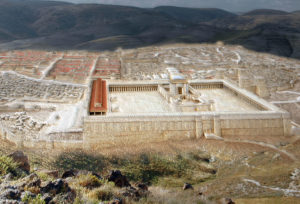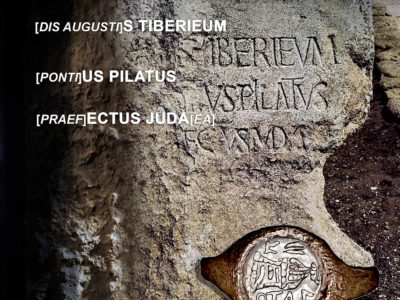BIBLE PEOPLE DON’T OFTEN SHOW UP in archaeological discoveries. But the man who sent Jesus to the cross—Roman governor Pontius Pilate—just recently made his second appearance.
Scholars identified what appears to be the head of his signet ring, used as a stamp of the governor’s official approval.
It looks like it was a cheap ring, made of copper. One of his officials may have worn it while doing the governor’s more routine work.
The letters are etched in Greek, the international language of the day, much like Spanish or English today. The letters frame a wine vessel that’s laying on its side in the accompanying photo. It’s a krater, which Romans used to mix wine and water.
Because this is a signet ring, the letters are reversed so folks can read them once the ring is pressed into a plug of soft wax or clay to seal a document closed.
The two Greek letters for Pi (as in Pilate) sit on top: ΠΙ.
The rest of the name is reversed below: ΛΑΤΟ.
These letters spell the Greek version of Pilate’s Latin name.
- Greek: Pilato.
- Latin: Pilatus.
- English: Pilate.
That’s a bit like this.
- English: Stephen.
- Spanish: Esteban.
- French: Étienne.
The ring turned up 50 years ago in Herod’s summer palace built on the manmade hill called Herodium, south of Jerusalem. But only this winter did an archaeologist decide to clean it and examine it.
Running a little behind, are we?
I have some tile grout in my shower that will need cleaned in 2069.
Pilate chiseled in stone
Back in 1961, almost a decade before the ring first appeared, the “Pilate Stone” turned up in the ruins of what was Rome’s regional capital: the seaside city of Caesarea, named in honor of Caesar. The limestone slab includes part of Pilate’s name and title as a prefect, or governor, of the province Romans called Judea. Today, that region is the traditional homeland of Jews and Palestinians: Israel and Palestinian Territories.
Pilate apparently commissioned this stone to honor his boss, “Tiberius Caesar.” In doing so, he managed to preserve his name in stone for 2,000 years.
More Pilate
For more about Pontius Pilate, since his sad season is upon us:


How could the Pilate stone be in Latin and the ring be in Greek
As I indicated in the caption to the photo, the stone is replica of the one they found. I believe the ring is a contemporary addition to the stone. Latin was the official language of the Romans. Greek was the international language of the day, much like English is today. Both languages were widely used during the time when the Roman empire controlled much of the Mediterranean coastline.